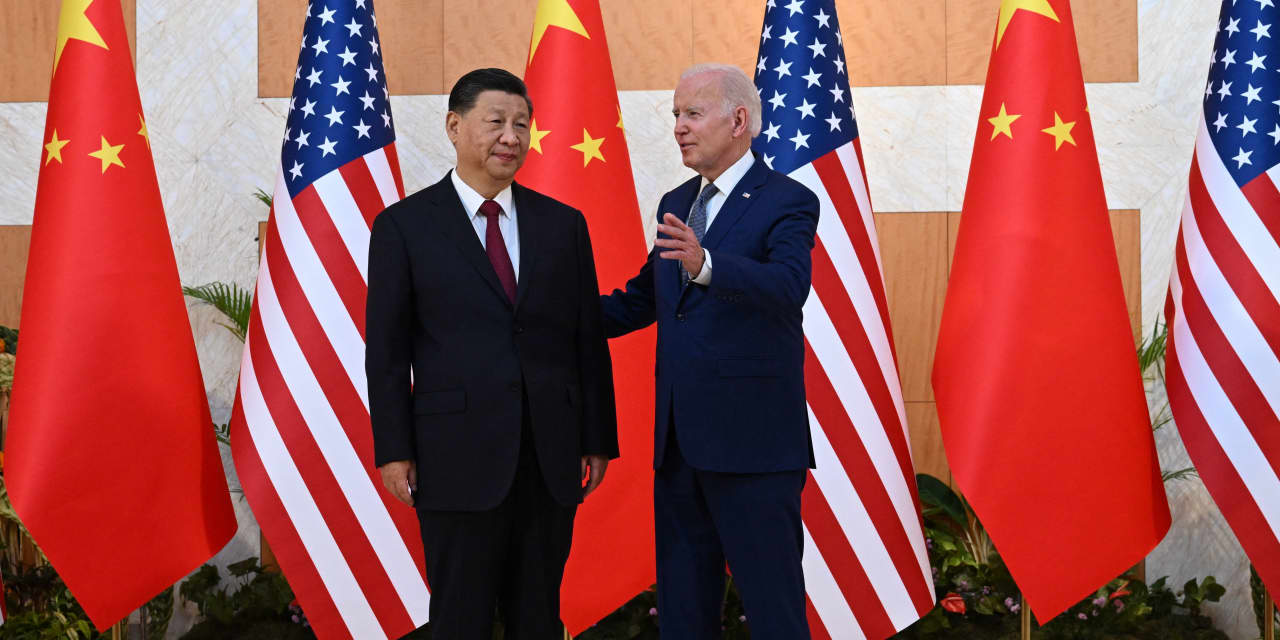U.S. President Joe Biden and Chinese President Xi Jinping at the 2022 G20 Summit in Bali, Indonesia.
Saul Loeb/AFP/Getty Images
About the author: Michael Froman is president of the Council on Foreign Relations and a former U.S. Trade Representative.
Next week, world leaders will converge on San Francisco for a widely anticipated gathering of the Asia-Pacific Economic Cooperation forum, known as APEC. APEC was never intended to produce concrete, enforceable commitments, and that will likely remain the case this year. But the forum still has an important role to play in forcing action on other diplomatic efforts, specifically an expected summit between President Biden and Chinese President Xi Jinping and an early harvest of agreements under the Indo-Pacific Economic Framework.
This year’s APEC leaders’ summit marks 30 years since President Clinton held the first such forum on Blake Island, Wash. APEC has since grown to cover 21 economies, nearly half of world trade and over 60% of global gross domestic product. U.S. exports to APEC economies support 7 million U.S. jobs. This progress was founded on an intense appetite for economic liberalization that is more muted today. That first summit drove momentum toward the World Trade Organization’s creation, and APEC’s 2011 summit in Honolulu, which I helped oversee under President Obama, delivered specific targets to reduce barriers to environmental trade, improved regulatory practices, and marked a major milestone in the negotiation of the Trans-Pacific Partnership.
The goal of this year’s APEC leaders’ meeting is to foster an “interconnected, innovative, and inclusive” Asia-Pacific to create a “resilient and sustainable future for all.” There are likely to be modest agreements on the energy transition and food security, anticorruption, trade facilitation, and environmental goods. But given the conflicts in Ukraine and the Middle East, tensions over the future of the Western Pacific, and divisions over issues like climate change, simply reaching consensus on a meaningful Leaders’ Statement could prove difficult.
Instead, much of the focus has been on an expected bilateral between Presidents Biden and Xi. That meeting is seen as an effort to draw a line under the U.S.-China relationship after the spy balloon incident and would cap off months of outreach from senior officials of both countries. The issues requiring Sino-U.S. cooperation are legion: climate change, nonproliferation, AI, fentanyl, trade disputes and very importantly, military-to-military communications. Thankfully, China lately seems more open to resolving some of them.
However, Beijing and Washington remain far apart on defining the nature of the bilateral relationship going forward and what a new equilibrium might look like. Biden has articulated a framework of cooperation, competition, and confrontation, and Xi has countered with his own triptych of mutual respect, peaceful coexistence, and win-win cooperation. No grand bargains can be expected from this meeting. Instead, the meeting itself is the deliverable. It will restore a semblance of stability to the relationship in the way only leader-level engagement can. This is particularly important with presidential elections coming up in Taiwan and the United States next year.
At the same time, the Indo-Pacific Economic Framework will hold a seventh negotiating round in San Francisco just days before the summit. IPEF is Biden’s signature project for expanding U.S. economic leadership in the region. Skeptics have long criticized IPEF for its lack of tariff concessions, which ostensibly makes the deal less attractive to partners, making it difficult to secure meaningful concessions in return. The fact that IPEF’s trade pillar will likely see little movement at APEC regarding its most substantive agenda items—namely, labor, environmental, and digital trade—may reinforce those concerns.
Still, if negotiations go smoothly, the progress IPEF will make is nontrivial: Alongside 11 APEC economies, plus India and Fiji, the U.S. expects to sign a final agreement on IPEF’s supply chain pillar. It will establish new cooperative mechanisms to build supply chain resilience, coordinate during disruptions, and promote labor rights among suppliers. Administration officials also hope to conclude understandings on the green transition, tax, and anti-corruption pillars. Though traditional trade deals often take years to negotiate, IPEF has done all this in only 18 months.
But beyond these deliverables, IPEF’s primary value is strategic. It provides an opportunity for U.S. economic engagement in the region and a platform to counterbalance China’s magnetic economic pull, embodied by infrastructure projects under the Belt and Road Initiative and trade deals like the Regional Comprehensive Economic Partnership. Moreover, in a world in which global average tariffs have come down substantially and the importance of services has grown—80% of U.S. workers are in the service sector—IPEF can still provide meaningful benefits to members even without cutting tariffs, should it seek to address rules and standards that facilitate trade.
One dynamic has become clear. More and more often, governments alone cannot address the global challenges we face, from pandemics to the energy transition to emerging technologies. That means the private sector has a critical role to play in innovating, investing in, and scaling solutions. Here, APEC has been a leader in building a bridge between the public and private sectors, from its Business Advisory Council to the CEO Summit, as well as bringing civil society to the table, creating habits of cooperation and stakeholder buy-in.
At its best, this year’s APEC will help advance some decent policy initiatives, encourage public-private cooperation, stabilize the most important bilateral relationship, and, very importantly, demonstrate continued U.S. commitment to exercising leadership in the region, despite conflicts abroad and a potential government shutdown at home.
Guest commentaries like this one are written by authors outside the Barron’s and MarketWatch newsroom. They reflect the perspective and opinions of the authors. Submit commentary proposals and other feedback to [email protected].
Read the full article here










